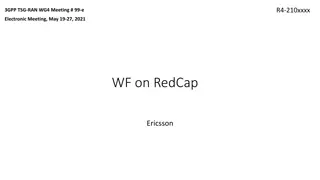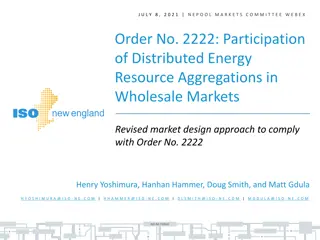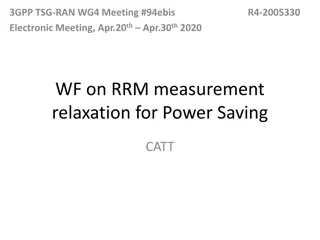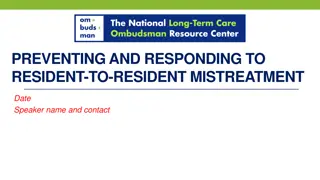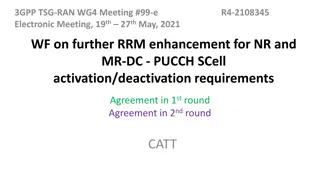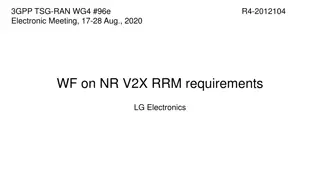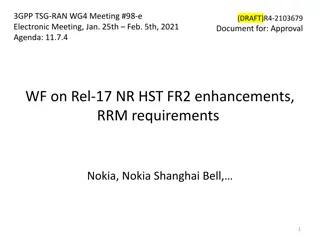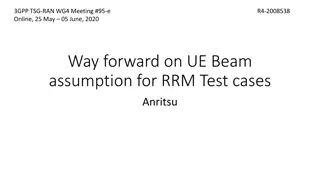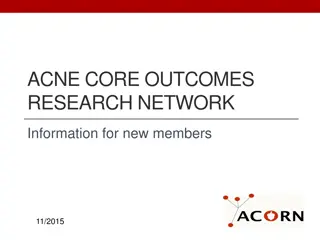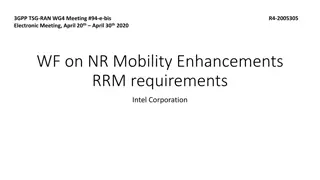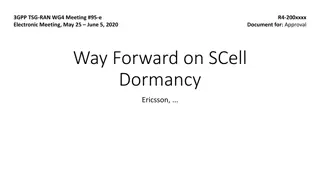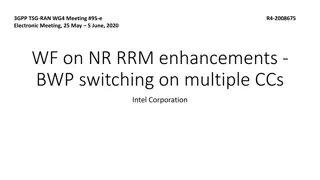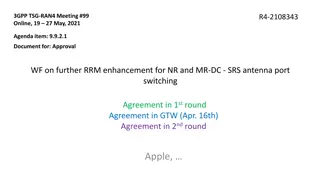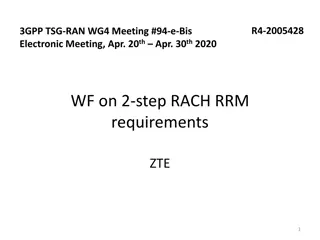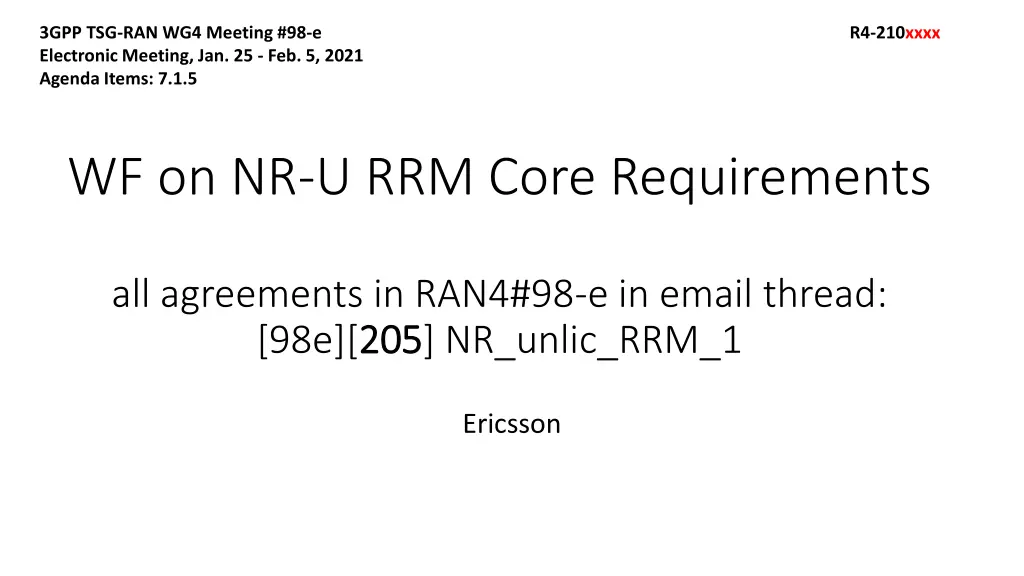
NR-U RRM Core Requirements and Specification Structure for 2-step RA in Rel-16
Explore the essential agreements and principles concerning NR-U RRM core requirements, SMTC occasions, and impact of DRX, MGRP, CSSF. Dive into the definition of availability with measurement cycles and gaps, as well as random access requirements for 2-step RA in Rel-16 NR-U. Understand the UE behavior with respect to LBT-FailureRecoveryConfig.
Download Presentation

Please find below an Image/Link to download the presentation.
The content on the website is provided AS IS for your information and personal use only. It may not be sold, licensed, or shared on other websites without obtaining consent from the author. If you encounter any issues during the download, it is possible that the publisher has removed the file from their server.
You are allowed to download the files provided on this website for personal or commercial use, subject to the condition that they are used lawfully. All files are the property of their respective owners.
The content on the website is provided AS IS for your information and personal use only. It may not be sold, licensed, or shared on other websites without obtaining consent from the author.
E N D
Presentation Transcript
3GPP TSG-RAN WG4 Meeting #98-e Electronic Meeting, Jan. 25 - Feb. 5, 2021 Agenda Items: 7.1.5 R4-210xxxx WF on NR-U RRM Core Requirements all agreements in RAN4#98-e in email thread: [98e][205 205] NR_unlic_RRM_1 Ericsson
Agreements from the 1st GTW session Agreements from the 1st round Agreements from the 2nd round
General Further NR-U terminology clarification General principles to address the impact of DRX, MGRP, CSSF, etc. on the availability definition: When configured with measurements in measurement cycles: the UE is not required to determine the availability of SMTC occasions more frequent than once per measurement cycle. For measurements in gaps: The UE is not required to determine the availability of SMTC occasions more frequent than once during MGRP. For measurement requirements with DRX: the UE is not required to determine the availability of SMTC occasions more frequent than once per DRX cycle. For RLM/CBD: The UE is not required to determine the availability of SSB occasions more frequent than once per DRX cycle length, when configured with DRX. FFS: how to account CSSF impact Option 1: For measurement requirements with CSSF: The UE is not required to determine the availability of SMTC occasions more frequent than what is required by CSSF A common approach (but applicable for the relevant issues among DRX, MGRP, etc.) shall be used for all measurements FFS: how to capture the above in 38.133 and the level of details
Random Access - General Supplementary UL Do not define RRM requirements for random access in supplementary uplink Note: The respective requirements can be discussed in the future when the corresponding RF band combinations including NR-U and SUL are introduced and also subject to the outcome of RAN1 discussion Specification structure for RA requirements in 38.133 The specification structure for clause 6.2.2A shall follow the structure of clause 6.2.2, but unnecessary sections can be omitted (do not use void for this purpose)
Random Access 2-step RA Define requirements for 2-step RA in Rel-16 NR-U Specification structure Create section 6.2.2A.3 for 2-step RA in NR-U 6.2.2A.3 Requirements for 2-step RA type 6.2.2A.3.1 Contention based random access 6.2.2A.3.1.1 Correct behaviour when transmitting MsgA 6.2.2A.3.1.2 Correct behaviour when receiving MsgB 6.2.2A.3.1.3 Correct behaviour when not receiving MsgB 6.2.2A.3.2 Non-contention based random access 6.2.2A.3.2.1 Correct behaviour when transmitting MsgA 6.2.2A.3.2.2 Correct behaviour when receiving MsgB 6.2.2A.3.2.3 Correct behaviour when not receiving MsgB
Random Access 2-step RA (cont.) UE behaviour with respect to lbt-FailureRecoveryConfig: When lbt-FailureRecoveryConfig is configured and is capable of ul-LBT-FailureDetectionRecovery [2]: The UE shall perform LBT failure detection and recovery procedure as outlined in Clause 5.21.2 of TS 38.321. For 2-step RA, if UL LBT failure is indicated by the lower layers for a Random-Access Preamble transmission, the UE shall: Cancel the transmission of the msgA payload on the associated PUSCH resource Perform the Random-Access Selection procedure and as specified in Clause 5.1.2a of TS 38.321 for 2-step RA. When lbt-FailureRecoveryConfig is not configured or is not capable of ul-LBT- FailureDetectionRecovery [2]: For 2-step RA, if UL LBT failure is indicated by the lower layers, the UE shall Cancel the transmission of the msgA payload on the associated PUSCH resource Increment the PREAMBLE_TRANSMISSION_COUNTER by 1 The UE shall again perform the Random Access Resource selection procedure if PREAMBLE_TRANSMISSION_COUNTER < preambleTransMax + 1, as specified in clause 5.1.3a in TS38.321. If the Random Access Procedure is not complete and the UE is configured with msgA-TransMax then, as specified in clause 5.1.3a in TS 38.321 [7], the UE shall perform the Random Access Resource selection procedure with 4- step RA type provided that PREAMBLE_TRANSMISSION_COUNTER = msgA-TransMax + 1
Random Access 4-step RA Specification structure 6.2.2A.1 Introduction 6.2.2A.2 Requirements for 4-step RA type 6.2.2A.2.1 Contention based random access 6.2.2A.2.1.1 Correct behaviour when transmitting Random Access Preamble 6.2.2A.2.1.2 Correct behaviour when receiving Random Access Response 6.2.2A.2.1.3 Correct behaviour when not receiving Random Access Response 6.2.2A.2.1.4 Correct behaviour when receiving an UL grant for msg3 retransmission 6.2.2A.2.1.5 Correct behaviour when receiving a message over Temporary C-RNTI 6.2.2A.2.1.6 Correct behaviour when contention Resolution timer expires 6.2.2A.2.2 Non-contention based random access 6.2.2A.2.2.1 Correct behaviour when transmitting Random Access Preamble 6.2.2A.2.2.2 Correct behaviour when receiving Random Access Response 6.2.2A.2.2.3 Correct behaviour when not receiving Random Access Response
Random Access 4-step RA (cont.) UE behaviour with respect to lbt-FailureRecoveryConfig: When lbt-FailureRecoveryConfig is configured and is capable of ul-LBT- FailureDetectionRecovery [2]: The UE shall perform LBT failure detection and recovery procedure as outlined in Clause 5.21.2 of TS 38.321. For 4-step RA, if UL LBT failure is indicated by the lower layers for a Random-Access Preamble transmission, the UE shall: Perform the Random-Access Selection procedure again as specified in Clause 5.1.2 of TS 38.321 for 4-step RA When lbt-FailureRecoveryConfig is not configured or is not capable of ul-LBT- FailureDetectionRecovery [2]: For 4-step RA, if UL LBT failure is indicated by the lower layers, the UE shall Increment the PREAMBLE_TRANSMISSION_COUNTER by 1 and perform the procedure as outlined in Clause 5.1.3 in TS 38.321
Random Access: Applicability rules for RA in other RRM requirements Update the applicability rules for 2-step RA and 4-step RA in 36.133 and 38.133 such that: 2-step RA and 4-step RA without CCA apply to RRM requirements where the RA is sent to a target cell NOT subject to CCA and 2-step RA and 4-step RA with CCA apply to RRM requirements where the RA is sent to a target cell subject to CCA The list of impacted RRM requirements in TS 36.133: No. 1 2 3 4 Clause 5.3.4 5.3.5 6.3.4 7.31.2 RRM requirements involving RA to NR target cell NOT subject to CCA E-UTRAN - NR FR1 handover requirements E-UTRAN - NR FR2 handover requirements RRC connection release with redirection to NR requirements PSCell addition delay requirements RRM requirements involving RA to NR target cell subject to CCA E-UTRAN - NR FR1 handover requirements RRC connection release with redirection to NR requirements PSCell addition delay requirements 5 6 7 5.3.4A 6.3.2.5 7.31A.2
Random Access: Applicability rules for RA in other RRM requirements (cont.) The list of impacted RRM requirements in TS 38.133: No. 1 2 3 4 5 6 7 Clause 6.1 6.2.1 6.2.3.2.1 7.1 8.9.2 8.11 8.11B RRM requirements involving RA to NR target cell NOT subject to CCA Handover requirements except for clauses 6.1.2 and 6.1B RRC connection re-establishment requirements RRC connection release with redirection to NR requirements UE transmit timing requirements PSCell addition delay requirements PSCell change requirements Conditional PSCell change requirements RRM requirements involving RA to NR target cell subject to CCA Handover requirements RRC connection re-establishment requirements RRC connection release with redirection to NR requirements UE transmit timing requirements 8 9 10 11 6.1B 6.2.1A 6.2.3.2.3 7.1
SI reading with LBT in RRC release with redirection, RRC re-establishment, and paging interruption FFS: defining a requirement on the minimum number of available samples for SI reading during the RRC release with redirection, RRC re-establishment, and paging interruption at a low operation point, e.g., at -3 dB For NR-U RRM test cases, TSI,CCA is set as follows, considering the agreed limited set of values for PCCA_DL: TSI,CCA(PCCA_DL = 0.25) = X1*TDBT TSI,CCA(PCCA_DL = 0.5) = X2*TDBT TSI,CCA(PCCA_DL = 0.75) = X3*TDBT X1=[35], X2=[17], X3=[10] No other margins are needed
SCell Activation: Interruptions General Further discuss the following 2 types of interruptions Interruptions on any active cell in the same band with the SCell being activated Interruptions on any active cell outside the band with the SCell being activated Interruptions for inter-band CA For any active cell in the same band with the SCell being activated, the interruption requirements (i.e. number of interruptions and starting point of an interruption) for intra-band CA apply For any active cell outside the band with the SCell being activated, the interruption requirements are FFS For the known target SCell: FFS: a single interruption applies, regardless of whether the victim cell is on an intra-band or inter-band CC For unknown target SCell: Scenario with victims on inter-band CCs only (no intra-band victim serving cells): single interruption Scenario with victims on inter-band CCs and intra-band CCs: FFS
SCell Activation: sCellDeactivationTimer is NOT configured Applicability of SCell activation requirements when sCellDeactivationTimer is NOT configured Option 1 (E///, QC, Apple, Huawei/HiSilicon): The SCell activation requirements for NR-U do not apply when the sCellDeactivationTimer is not configured, when the SCell activation delay exceeds some pre-defined time (e.g., equivalent or comparable to the longest possible value of sCellDeactivationTimer). Option 2 (Nokia, ZTE, MTK): SCell activation delay requirements are applicable in Scenario A (CA with NR PCell and NR SCell) with any LBT type and in Scenario B and C (E-UTRAN-NR-U DC/SA NR-U) with LBT type 2C. Requirements are also applicable in all scenarios, if the UE does not experience any UL LBT failures during SCell activation/deactivation. SCell activation delay requirements are applicable when sCellDeactivationTimer is not configured also in Scenarios B and C (EN-DC and SA) LBT types other than 2C. Option 3 (possible compromise solution): SCell activation delay requirements are applicable in Scenario A (CA with NR PCell and NR SCell) with any LBT type and in Scenario B and C (E-UTRAN-NR-U DC/SA NR-U) with LBT type 2C. Requirements are also applicable in all scenarios, if the UE does not experience any UL LBT failures during SCell activation/deactivation. For all other scenarios the SCell activation requirements for NR-U do not apply when the sCellDeactivationTimer is not configured, when the SCell activation delay exceeds some pre-defined time (e.g., equivalent or comparable to the longest possible value of sCellDeactivationTimer).
RLM The RLM requirements under CCA in clause 8.1A apply regardless of whether CO-DurationPerCell is configured or not [TS 38.213] No need to explicitly capture this in TS 38.133
Beam Management: Link Recovery The link recovery requirements under CCA in clause 8.5A apply regardless of whether CO-DurationPerCell is configured or not [TS 38.213] No need to explicitly capture this in TS 38.133
Measurement Requirements: L1-RSRP Semi-persistent L1-RSRP measurement reporting Capture the following sentence in TS38.133 9.5A.3.2: When CCA is used on target frequency, the UE shall stop semi-persistent L1-RSRP measurement reports on PUCCH, when the UE cannot transmit a PUCCH with HARQ-ACK information in slot n corresponding to the PDSCH carrying the deactivation command The L1-RSRP requirements under CCA in clause 9.5A apply regardless of whether CO-DurationPerCell is configured or not [TS 38.213] No need to explicitly capture this in TS 38.133
Measurement Requirements: SFTD NR-U bands in SFTD accuracy requirements in TS 36.133: Add NR unlicensed bands to SFTD accuracy requirements in TS 36.133 clause 9.1.27
Measurement Requirements: CSSF CSSF outside measurement gaps for carrier frequency with CCA CSSF outside gaps (CSSFoutside_gap,i ) should increase by one if one MO configured both RMTC (for RSSI measurement) and SMTC (for SSB-based measurement) CSSF within measurement gaps for carrier frequency with CCA CSSF within measurement gaps (CSSFwithin_gap,i ) needs also to be adapted to account for inter-frequency RSSI/CO measurements and intra-frequency RSSI/CO measurements with gaps Regarding the CSSF within measurement gaps (CSSFwithin_gap,i ), a MO should be counted twice, if the MO is configured with both RMTC and SMTC which are candidates to be measured in gap j where the measurement object i is also a candidate
Other PL-RS switching for Rel-16 NR-U Do not include RRM requirements for PL-RS switching in Rel-16 NR-U Rel-16 CGI reading for Rel-16 NR-U Do not include RRM requirements for the Rel-16 CGI reading feature in Rel-16 NR-U


